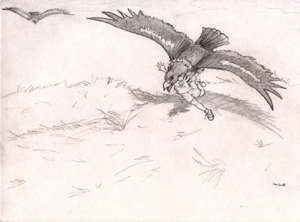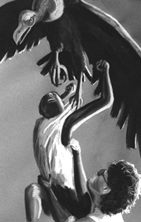Thunderbird

Thunderbird
By Craig Heinselman
The Comanche tribe call it ba'a' and the Potawatomi use the name chequah, but most people know of this mystery animal as Thunderbird. Although gigantic birds are reported in the past and present from various areas of the globe, the Thunderbird is isolated to North America. Native Americans believed that these giant birds brought thunder and rain with them as they flew through the air by flapping their wings, and lightning by closing their eyes. Nevertheless, the distinction between the stories of the Native Americans and people of today are not too far apart. Modern reports of Thunderbirds arise from various locations in North America, with a large occurrence from Pennsylvania to the Central states. Mark A. Hall, one of the foremost investigators of the Thunderbird story, gives the following description of the avian cryptid drawn from numerous sightings:
"The bird is distinguished by its size and lifting capabilities exceeding those of any known bird living today anywhere in the world. Wingspan estimates are necessarily all guesswork. But observers sometimes have had the benefit of a measurable object for comparison or the benefit of time to observe a resting bird. The results most often provide sizes of 15 to 20 feet. The bird at rest or on the ground appears to be four to eight feet tall. Typically the coloring of the birds overall is dark.."
Remarkably, a bird of 15 feet in size would be the largest bird known in the world today. The largest wingspan known on a living bird is that of the wandering albatross (diomedea exulans) with a wingspan to 12 feet, and while not a predatory bird, it still boasts an impressive span. The Andean condor (Vultur gryphus) and the California condor (Gymnogyps californianus) are among the largest predatory birds in the world, with the Andean condor reaching a wingspan of 10.5 feet and the California condor (the largest North American predatory bird) reaches a wingspan of up to 10 feet. These are all truly marvelous birds and respectable in their majesty.
But consider the Thunderbird, reputedly capable of lifting a deer or a person from the ground. The current predatory birds are not equipped with grasping feet that are strong enough to hold much weight, instead they live primarily as carrion eaters and are only seldom predatory, and then usually on smaller animals. Reports of the Thunderbird, however, describe lifting deer and humans off the ground.
The attempted abduction of Marlon Lowe,
by Chelsea Sams
The attempted abduction of Marlon Lowe,
by William Rebsamen
Perhaps the most controversial inclusion of the Thunderbird capable of lifting a human comes from 1977 in Lawndale, Illinois. It was here that on July 25, 1977 towards 9:00 pm a group of three boys were in the backyard. They saw two large birds coming, and as the birds came in closer they went after the boys. Two of the boys escaped, but the third, Marlon Lowe, did not. One of the birds clamped onto his shoulder with its claws and proceeded to lift the ten year old boy about two feet off the ground for a distance of at least 30 yards. With screams of distress calling adults outside and coupled with a series of blows by the 65-pound boy, the bird finally released him. The boy was relatively unharmed, with psychological damage instead of physical.
Although viewed by some as a tall tale, the descriptions given by the witnesses of these birds describe a large black bird, with a white ring on its neck and a wingspan of up to 10 feet, traits oddly reminiscent of the Andean condor (Vultur gryphus) which exhibits the same basic physical characteristics as that of the Lawndale bird. To this day, no one can explain away the incident from 1977 in any convincing manner, either the incident didn't happen or a large bird (of known or unknown status) attacked and carried a small boy one summer night to his and his family's terror.
The evidence thus far for the existence of a large undescribed predatory bird in North America is based on historical and modern anecdotal evidence with no physical evidence. There are however two tantalizing images of the Thunderbird, or at least of a large bird. The first was taken in the same year as Marlon Lowe's attack and in the same state. On July 30, 1977 John Huffer, an ex-marine and photographer, took a 100 foot roll of color film of two birds taking off from a tree in an inlet of Lake Shelbyville. The film concentrates on one of the birds only. Highly controversial, and thought by many to be of a turkey vulture, it sits as a little known film of a possible mystery animal. To date little, if any, evaluation of the birds in the film has been done. The Discovery Channel in their program "Into the Unknown" did give the film some mention, with a dismissal of a medium sized bird, probably a vulture.
The other possible photographic evidence is even more of a mystery, as it may not exist at all!! The image in question is the "Thunderbird Photograph" taken at the end of the nineteenth century in Texas. The image is said to depict six western clothed adult men, standing fingertip to fingertip in front of a barn where a large bird is nailed to the wall. Many have claimed to have seen or held this infamous image, including the late Ivan T. Sanderson who reportedly had acquired a photocopy of the image in 1966, the same year in which Sanderson gave the image, later lost, to a couple of men from Pennsylvania who were searching for the Thunderbird. The image has yet to surface, and may well not exist at all. The image was reported to have been published in 1886 in the Tombstone Arizona Epitaph, however this was somewhat dubiously reported in a 1963 article by Jack Pearl called "The Monster Bird That Carries Off Human Beings!" in Saga magazine. Searches of the Tombstone Epitaph have come up empty, aside from an article from April 26, 1890 of a 16 foot bird found in the desert by a couple of ranchers. So the mystery of the "Thunderbird Photo" is no closer to being solved then it was nearly 40 years ago during its first mention.
What then is the Thunderbird? It is a mystery. It has been reported by Native Americans and people today from all walks of life as an enormous bird, larger than any known species, but similar in appearance to a condor. Theories as to what the Thunderbird may be have run the gamut from surviving pterodactyls to the teratorns. The teratorns were large predatory birds from the Pleistocene that exhibited wingspans of upwards of 25 feet. Although thought to be extinct, their general presumed appearance is that of a giant condor-like species, similar in appearence to the Thunderbird. North America has many mysteries, among them the Thunderbird. These creatures are surely one of the most enigmatic cryptids in the world. With misinformation abounding, such as the "Thunderbird Photograph," and the lack of support in searching for these birds, it is no wonder that these creatures have evaded discovery like so many others from around the world.
Selected Sources:
Clark, Jerome, The Unexplained 2nd Edition, Visible Ink, Detroit, 1999
Coleman, Loren and Clark, Jerome, Cryptozoology A to Z, Simon & Schuster, New York, 1999
Coleman, Loren, Curious Encounters, Faber and Faber, Boston, 1985
Hall, Mark A., Thunderbirds Are Go, Fortean Times No. 105, December 1997
Hall, Mark A., Thunderbirds - The Living Legend! 2nd Edition, MAHO, Minneapolis, 1994
Pearl, Jack, Monster Bird That Carries Off Human Beings, Saga, May 1963
Sanderson, Ivan T., Thunderbirds Again and Again, Pursuit: Journal of the Society for the Investigation of the Unexplained, April 1972
Shuker, Karl P.N., In Search of Prehistoric Survivors, Blandford, London, 1995
